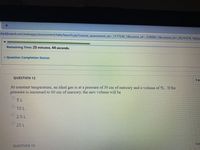
College Physics
11th Edition
ISBN: 9781305952300
Author: Raymond A. Serway, Chris Vuille
Publisher: Cengage Learning
expand_more
expand_more
format_list_bulleted
Question

Transcribed Image Text:| +
plackboard.com/webapps/assessment/take/launch.jsp?course_assessment_id=_1177536_1&course_id%3_330880 1&content_id=_20210374_1&ste
Remaining Time: 25 minutes, 44 seconds.
¥ Question Completion Status:
5 p
QUESTION 12
At constant temperature, an ideal gas is at a pressure of 30 em of mercury and a volume of 5L. If the
pressure is inereased to 60 cm of mercury, the new volume will be
II ST
5L
10 L
2.5 L
O 25 L
5 pc
QUESTION 13
Expert Solution
This question has been solved!
Explore an expertly crafted, step-by-step solution for a thorough understanding of key concepts.
This is a popular solution
Trending nowThis is a popular solution!
Step by stepSolved in 2 steps

Knowledge Booster
Learn more about
Need a deep-dive on the concept behind this application? Look no further. Learn more about this topic, physics and related others by exploring similar questions and additional content below.Similar questions
- 7. The figure shows a 50 kg lead cylindrical piston which floats on 0.68 mol of compressed air at 30°C. How far does the piston move if the temperature is increased to 300°C? 130 cm 250 cm 50 kg 1300 cm 120 cm 30°C 10 cmarrow_forwardGas is confined in a tank at a pressure of 12.7 atm and a temperature of 24.0°C. If two-thirds of the gas is withdrawn and the temperature is raised to 67.0°C, what is the pressure of the gas remaining in the tank?arrow_forwardNeed helparrow_forward
- Gas is confined in a tank at a pressure of 9.2 atm and a temperature of 21.5°C. If two-thirds of the gas is withdrawn and the temperature is raised to 85.0°C, what is the pressure of the gas remaining in the tank? ?atmarrow_forwardA quantity of mercury occupies 400.0 cm³ at 0°C. What volume will it occupy when heated to 50°C? Mercury has a volume expansion coefficient of 180 x 10-6 K-1. 450 cm3 401.8 cm3 O403.6 cm³ O409.7 cm3arrow_forwardYou happen to come across a piece of metal that has a density of p = 7.43 g/cm³ when the temperature is To = 45.0 °C. If the metal is cooled to a temperature of T = 0.00 °C, does the density change? No, because as the volume changes so does the mass. No, density does not depend on temperature. Yes, since the metal contracts and the mass is constant, the density will increase. Yes, the density will decrease since the volume changes. Calculate the density of the piece of metal at this temperature, p1. The coefficient of volume expansion for this piece of metal is ß = 8.43 x 10-s 1°°C.arrow_forward
- The boiling point of a liquid is 28.3°C. A portion of the liquid is at equilibrium with its vapor at 22.3°C in a sealed flask. The temperature rises to to 32.6°C.What happens inside the container? Liquid is converted to vapor, the new equilbrium mixture contains less liquid and more vapor. The vapor is all converted to liquid. Vapor is converted to liquid, the new equilibrium mixture contains more liquid and less vapor. The liquid is all converted to vapor.arrow_forward33. A bicycle tire has a pressure of 7.00 × 10° N/m² at a temperature of 18.0°C and contains 2.00 L of gas. What will its pressure be if you let out an amount of air that has a volume of 100 cm³ at atmospheric pressure? Assume tire temperature and volume remain constant.arrow_forwardIf 23.5 moles of an ideal gas occupies 0.0465 cubic meters at 14.5 °C, what is the pressure of the gas? pressure: Paarrow_forward
- A container of gas holds 0.74 moles of neon gas. If the volume of the container is 11.8 liters and the pressure inside is 1.97 atm, what is the temperature (in K) of the gas?arrow_forwardGas is confined in a tank at a pressure of 13.1 atm and a temperature of 28.0°C. If two-thirds of the gas is withdrawn and the temperature is raised to 89.0°C, what is the pressure of the gas remaining in the tank?arrow_forwardA gas under constant pressure has a volume of 30.57m^3 and a temperature of 59.0 K. A change in temperature caused the volume to change to 121.14m^3. Based on the relationship between volume and temperature, what must have happened to the temperature? A- Temperature decreased B- Temperature increased C- Temperature stayed the same D- Temperature trend can not be determinedarrow_forward
arrow_back_ios
SEE MORE QUESTIONS
arrow_forward_ios
Recommended textbooks for you
 College PhysicsPhysicsISBN:9781305952300Author:Raymond A. Serway, Chris VuillePublisher:Cengage Learning
College PhysicsPhysicsISBN:9781305952300Author:Raymond A. Serway, Chris VuillePublisher:Cengage Learning University Physics (14th Edition)PhysicsISBN:9780133969290Author:Hugh D. Young, Roger A. FreedmanPublisher:PEARSON
University Physics (14th Edition)PhysicsISBN:9780133969290Author:Hugh D. Young, Roger A. FreedmanPublisher:PEARSON Introduction To Quantum MechanicsPhysicsISBN:9781107189638Author:Griffiths, David J., Schroeter, Darrell F.Publisher:Cambridge University Press
Introduction To Quantum MechanicsPhysicsISBN:9781107189638Author:Griffiths, David J., Schroeter, Darrell F.Publisher:Cambridge University Press Physics for Scientists and EngineersPhysicsISBN:9781337553278Author:Raymond A. Serway, John W. JewettPublisher:Cengage Learning
Physics for Scientists and EngineersPhysicsISBN:9781337553278Author:Raymond A. Serway, John W. JewettPublisher:Cengage Learning Lecture- Tutorials for Introductory AstronomyPhysicsISBN:9780321820464Author:Edward E. Prather, Tim P. Slater, Jeff P. Adams, Gina BrissendenPublisher:Addison-Wesley
Lecture- Tutorials for Introductory AstronomyPhysicsISBN:9780321820464Author:Edward E. Prather, Tim P. Slater, Jeff P. Adams, Gina BrissendenPublisher:Addison-Wesley College Physics: A Strategic Approach (4th Editio...PhysicsISBN:9780134609034Author:Randall D. Knight (Professor Emeritus), Brian Jones, Stuart FieldPublisher:PEARSON
College Physics: A Strategic Approach (4th Editio...PhysicsISBN:9780134609034Author:Randall D. Knight (Professor Emeritus), Brian Jones, Stuart FieldPublisher:PEARSON

College Physics
Physics
ISBN:9781305952300
Author:Raymond A. Serway, Chris Vuille
Publisher:Cengage Learning

University Physics (14th Edition)
Physics
ISBN:9780133969290
Author:Hugh D. Young, Roger A. Freedman
Publisher:PEARSON

Introduction To Quantum Mechanics
Physics
ISBN:9781107189638
Author:Griffiths, David J., Schroeter, Darrell F.
Publisher:Cambridge University Press

Physics for Scientists and Engineers
Physics
ISBN:9781337553278
Author:Raymond A. Serway, John W. Jewett
Publisher:Cengage Learning

Lecture- Tutorials for Introductory Astronomy
Physics
ISBN:9780321820464
Author:Edward E. Prather, Tim P. Slater, Jeff P. Adams, Gina Brissenden
Publisher:Addison-Wesley

College Physics: A Strategic Approach (4th Editio...
Physics
ISBN:9780134609034
Author:Randall D. Knight (Professor Emeritus), Brian Jones, Stuart Field
Publisher:PEARSON